Making applesauce from scratch is extremely easy, and in this post I'll show you how to make it unsweetened, sweetened, and flavored. It only takes 15 minutes on the stove, and the result is full of apple flavor, smooth, and way better than the one at the grocery store.
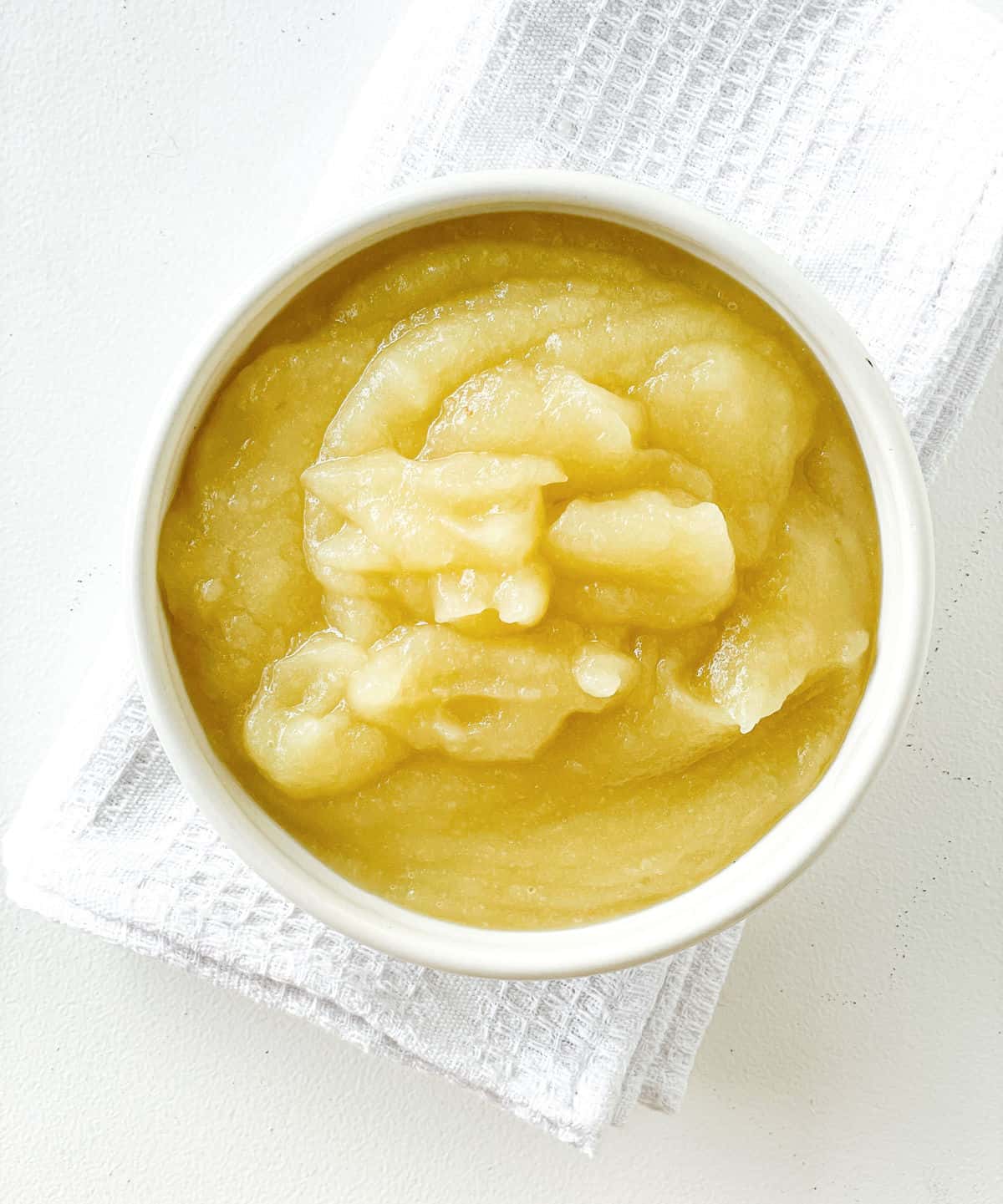
I feel about applesauce like I do about granola: why buy it when it's so easy to make at home, and the result is infinitely better?
It's a great substitute for ingredients like butter, sour cream or oil, and adds a lot of moisture to the crumb. Our favorites to bake once apple season hits are applesauce muffins and applesauce bread.
Whether summer is ending where you are or you're already looking forward to spring, a batch of applesauce will improve your day.
What is applesauce
Applesauce is made from cooked and puréed apples.
The process typically involves peeling, coring, and cooking apples until they are soft, and then mashing or processing them into a smooth consistency.
Applesauce can vary in texture, flavor, and sweetness depending on the type of apples used and any additional ingredients, such as sugar, cinnamon, or other spices, that may be added during the cooking process.
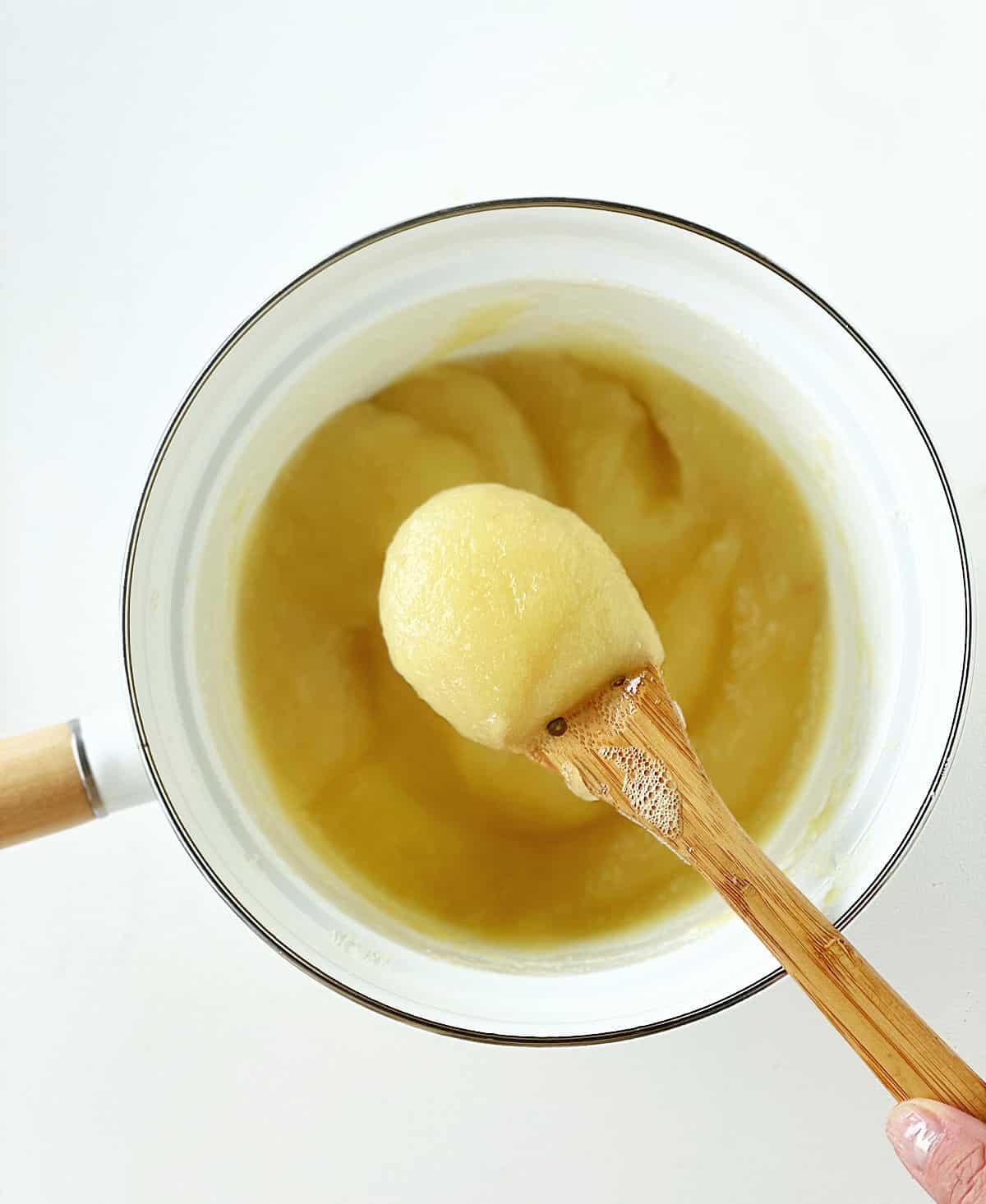
Why make this recipe
- Extremely easy: the only step that might take a little bit of time is peeling the apples. The rest is simply dumping them in a saucepan with a few ingredients and letting them cook until very soft before mashing or processing them.
- Flavorings: I like making unsweetened applesauce, but it's just as easy to sweeten or make it flavored by adding cinnamon for example. You can easily adjust the final product depending on what you're using it for.
- Keeps well: it can be kept in the refrigerator for a couple of weeks or months if you can it properly (like you would a jam).
Ingredients
- Apples: any type works, but I recommend a mix of red and green apples. As a rule, a pound of apples will render between a cup and a half and two cups of applesauce.
- Water
For sweetened applesauce
- Sweetener: we use white sugar or brown sugar but you can also use coconut sugar, honey, agave, muscovado sugar or maple syrup.
- Pinch of salt: is optional, but a small amount enhances flavors.
Flavorings
- Vanilla: It's a great way to add a tiny bit of flavor, especially when making all-natural applesauce (no sugar added). I use pure vanilla extract or pure vanilla paste when available, but a good vanilla essence (artificially flavored) also works.
- Citrus peel: I use lemon peel because it works very well with apples. Orange also pairs well with apples but adds a sweeter citrus flavor, not as sharp as the lemon.
- Cinnamon: ground cinnamon or cinnamon sticks, both work but they are different as the latter has a more subtle flavor.
- Other spices: you can use apple pie spice mix, or mix cinnamon with nutmeg, cloves, allspice, mace, or cardamom.
Best apples for applesauce
In theory, any apple you like is good for making applesauce as long as you use fresh ones.
- One kind: you can use just one type. For sweeter apples, I like golden delicious, Gala, or Fuji apples. For tart apples, I recommend the amazing Granny Smith (the green ones).
- Variety of apples: I use a mix of at least two, one of them tart apples like Granny Smith (the green ones), and the other a red one (usually red delicious). I recommend this because the flavor is deeper and one is more acidic, the other sweeter. The mix of both is great. I like choosing between Mc Intosh, Gala, and Red delicious depending on what's in season.
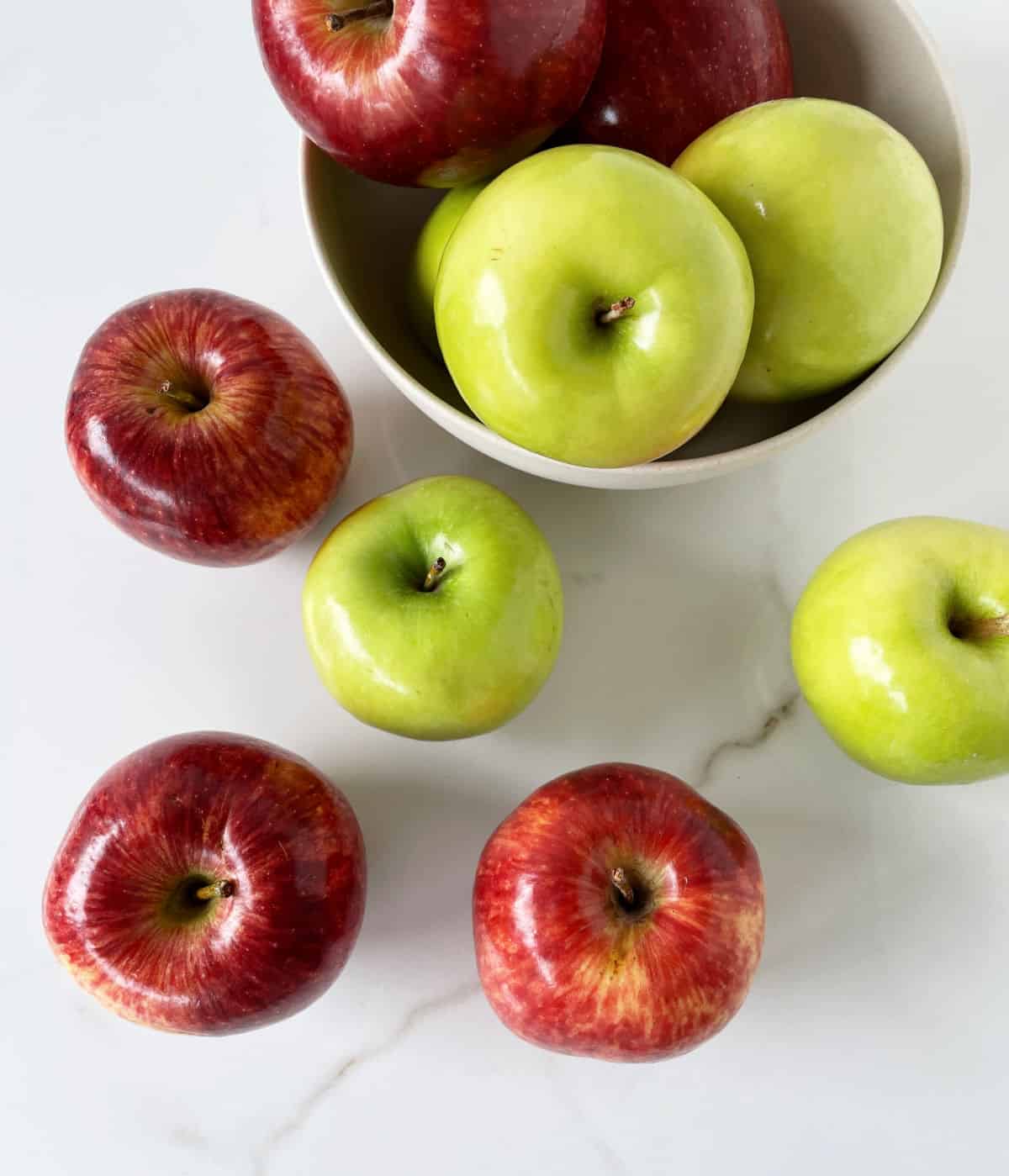
How to make applesauce
This is an easy recipe, so you need little equipment for this.
- Saucepan: the size and width of the pan will determine how long the apples take to soften. The wider and shallower, the faster it will be. Also, the apples will shrink a lot during baking, similar to what happens when we make an apple crisp recipe. So you can fill it up to ¾ with the fruit.
- Spoon or spatula: I use a wooden spoon or sometimes a silicon spoon because my saucepan is enameled. Depending on the type of material, you can use a regular spoon or any other utensil that can easily mix the ingredients.
- Peel the apples and add them to the saucepan with the water. This is as simple as it sounds. The size of the chunks is up to you. The larger the apple pieces the more they will take to soften. Image 1
- Sweetened applesauce. This is the moment where you add the sugar. Image 2
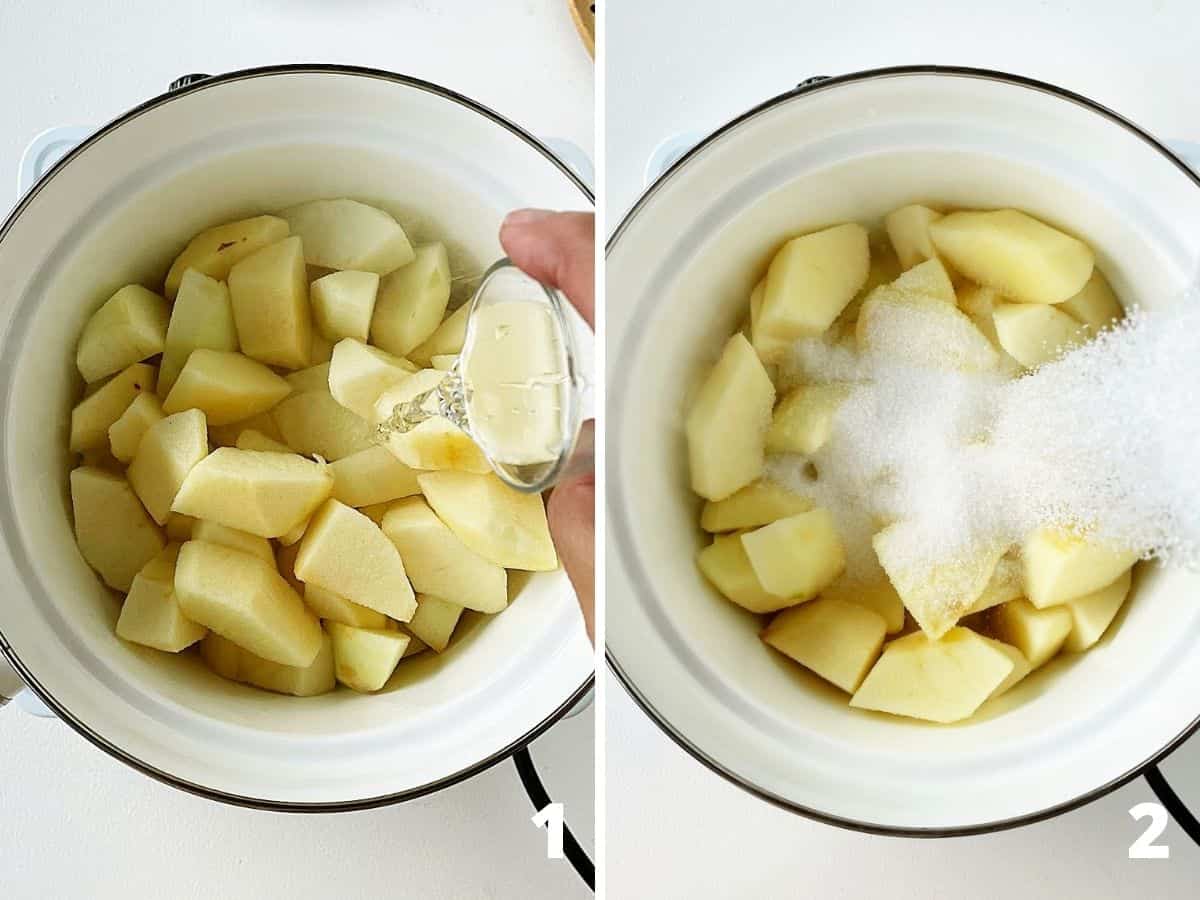
Adding flavorings
They can work for both sweetened and unsweetened applesauce. You can add all of them or only one. That is your choice and it greatly depends on what you're using the applesauce for. I like to make it completely plain because the cinnamon and other flavorings are already part of the muffins or bread.
- Lemon peel: I use the potato peeler and add a strip per pound of fruit. It adds some acid that balances very well the sugar if making sweetened applesauce. Image 3
- Cinnamon: use ground or a cinnamon stick, both work. But I find that the sticks have way less flavor than the ground cinnamon, so I don't usually use them. Image 4
- Vanilla: a little (like ⅛ teaspoon per pound of apples) of pure vanilla extract or paste mellows the other flavors. Don't overdo it unless you want strong vanilla-flavored applesauce. Image 4
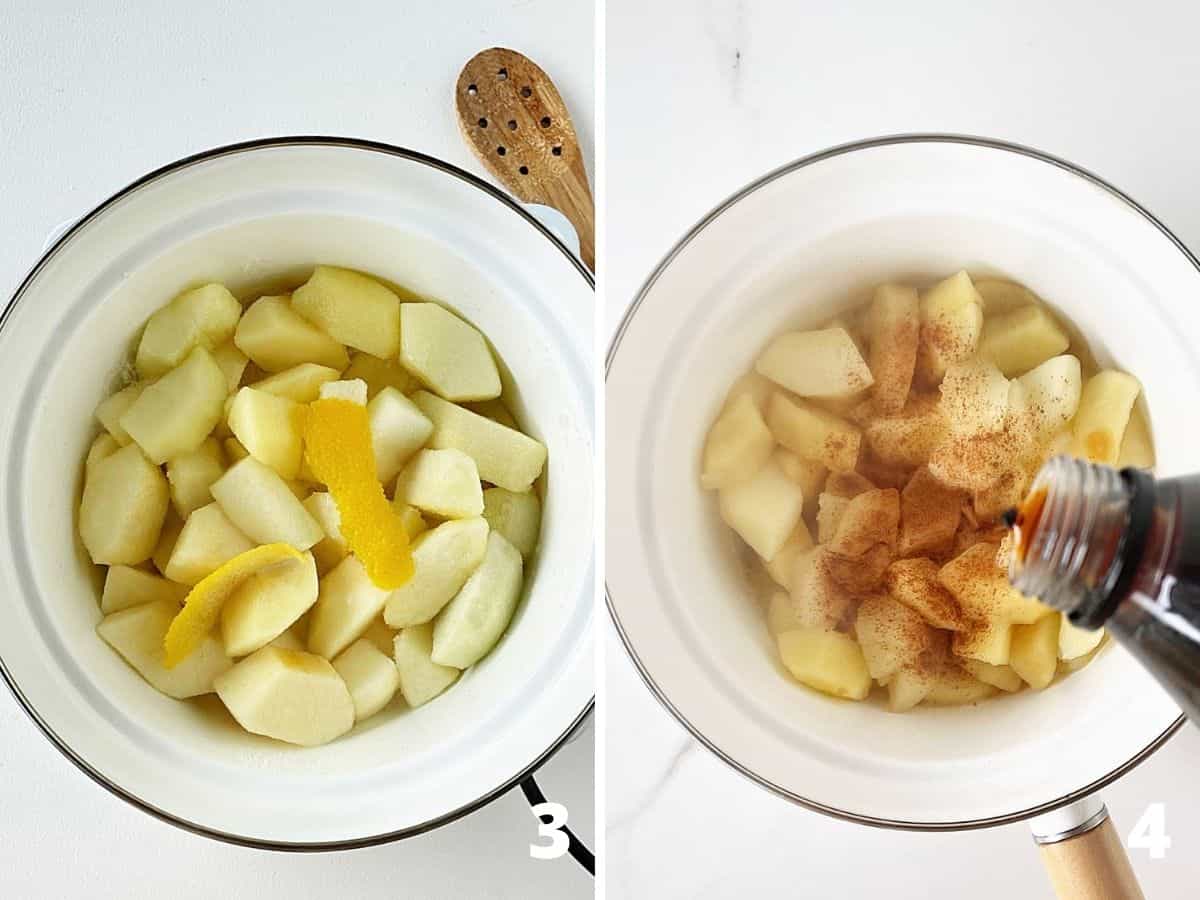
Cooking the apples
- Start with low heat and cover the pan. This way the mix will rapidly come to a simmer.
- Uncover and increase to medium heat. Let the whole mixture cook until the apples are very soft and the liquid is consumed by more than half. It will foam a lot and that is fine. Image 5
- Don't let the water consume completely. You don't want the apples to start browning or sticking to the bottom due to a lack of liquid. You just need to soften them enough to process and make a puree.
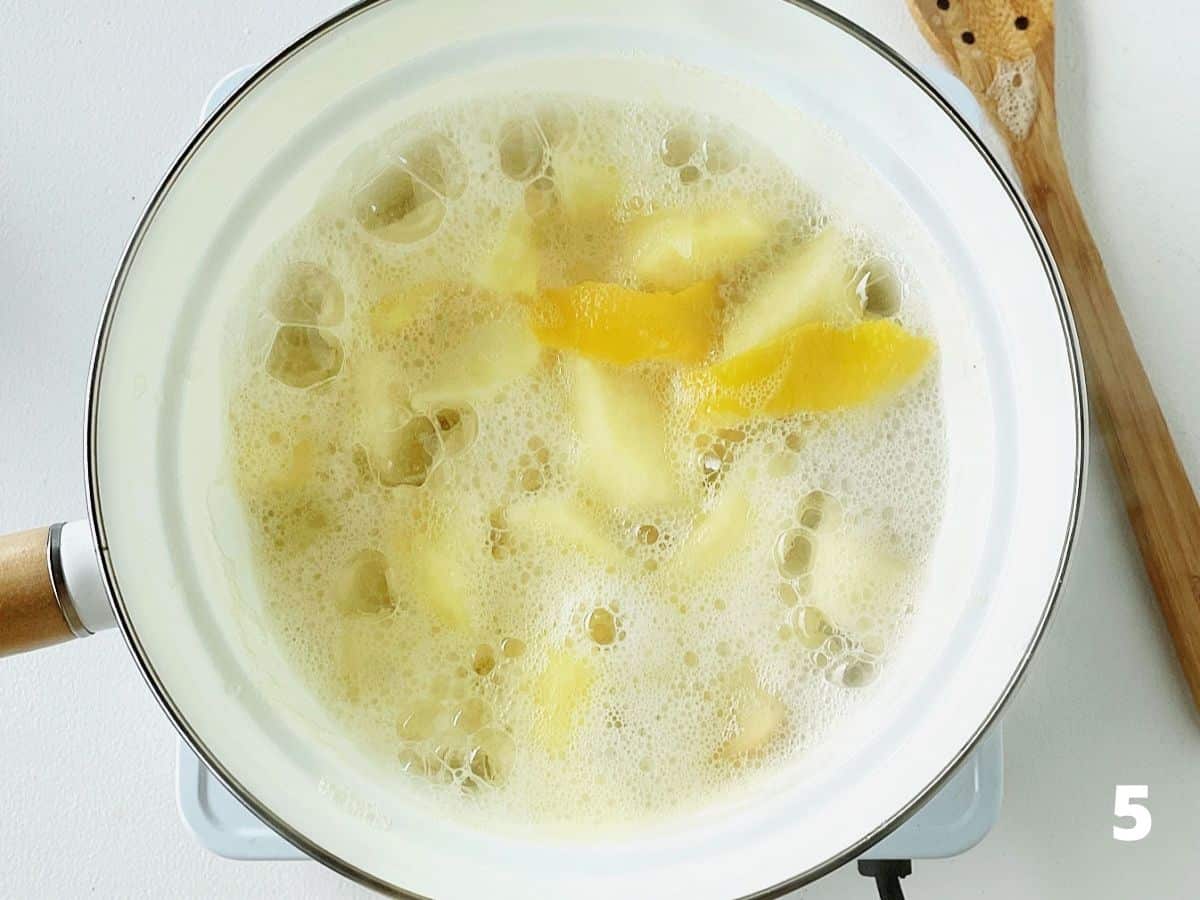
Processing the apples
- Potato masher: use it for making chunky applesauce. You will easily mash the soft apples but be able to retain some chunks. Image 6
- Immersion blender: for completely smooth applesauce, I find it's the easiest way to process the fruit because it can be done directly in the saucepan right after you remove it from the stove. Image 7
- Blender of food processor: if you use a blender, you might need to let it cool a little because not all blender jars are prepared to hold very hot mixtures. If you use a processor, make sure the amount of apples you make is enough for the steel blades to completely process them. If the amount is not large enough, sometimes the blades can't process it completely.
- Food mill: this is another option for making the apple puree, especially if you don't peel the apples. Pass them through a stainless steel food mill to separate the pulp from the peel. Since I peel my apples, I don't use it, but it's an alternative if you already have it.
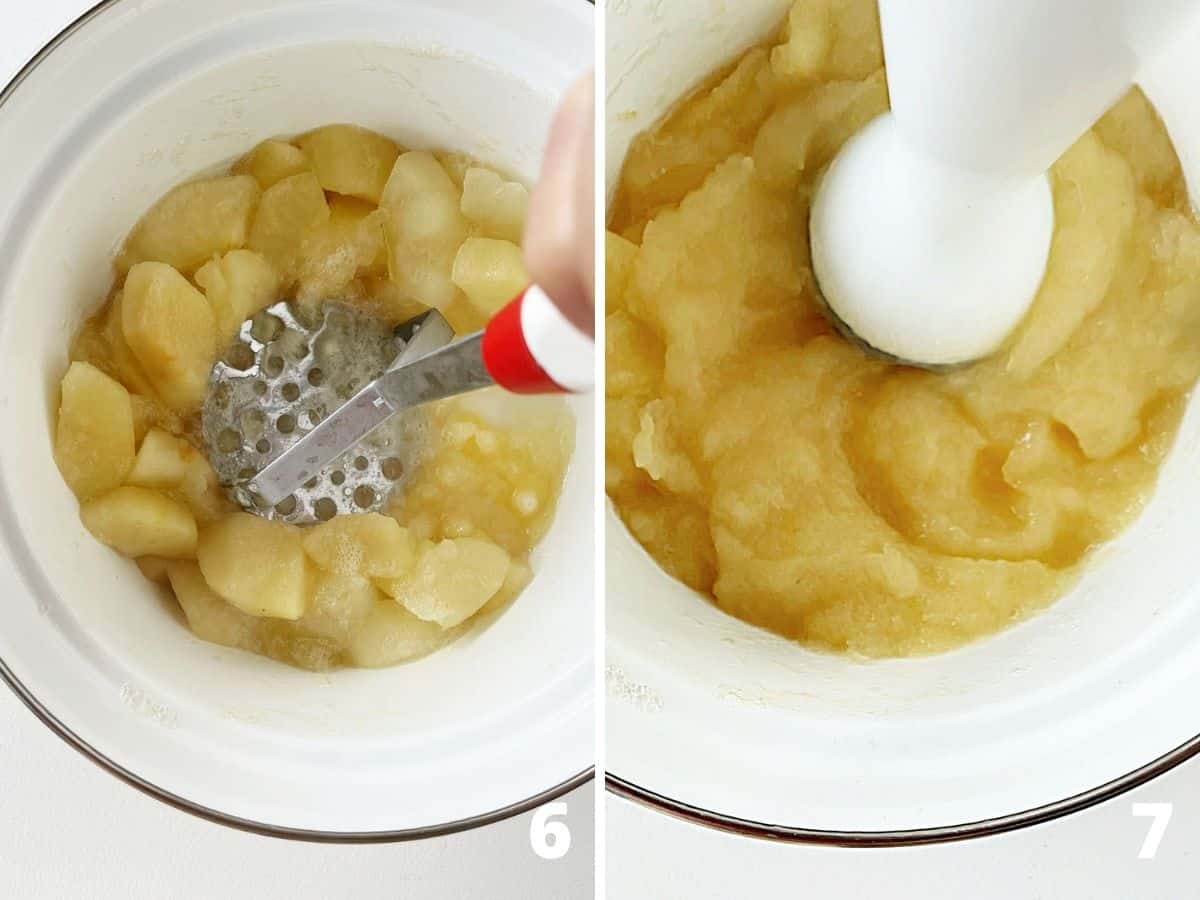
Kitchen notes
- Organization: always read the recipe first and make sure you have all the ingredients, at the right temperatures, and also the rest of the equipment and space to make it. This will make the process so much easier!
- Sweeteners: besides the white sugar that's in the recipe, you can use any type of brown sugar (light, dark, muscovado) or even coconut sugar. Alternatively, some maple syrup or honey works very well. I recommend adding them at the end when you remove the pan from the heat. Mix the sweetener and then mash or process the apples. They all sweeten differently, so adjust to your taste.
- Saucepan: use a pan that is large enough to hold all the apples. They shrink a lot during baking. If you fill it no more than half, the apples will cook faster than if you use a saucepan filled to the top.
- Uses: you can use it as a side dish (for pork chops for example), in baked goods like the blueberry applesauce loaf, applesauce muffins, applesauce bread, eat it with a spoon (baby food), or make applesauce pancakes. I love to bake with applesauce and substitute it in some recipes to make them healthier.
- Canning: if you can applesauce in jars it will keep for months in the refrigerator. Here is a step-by-step post on the whole canning applesauce process.
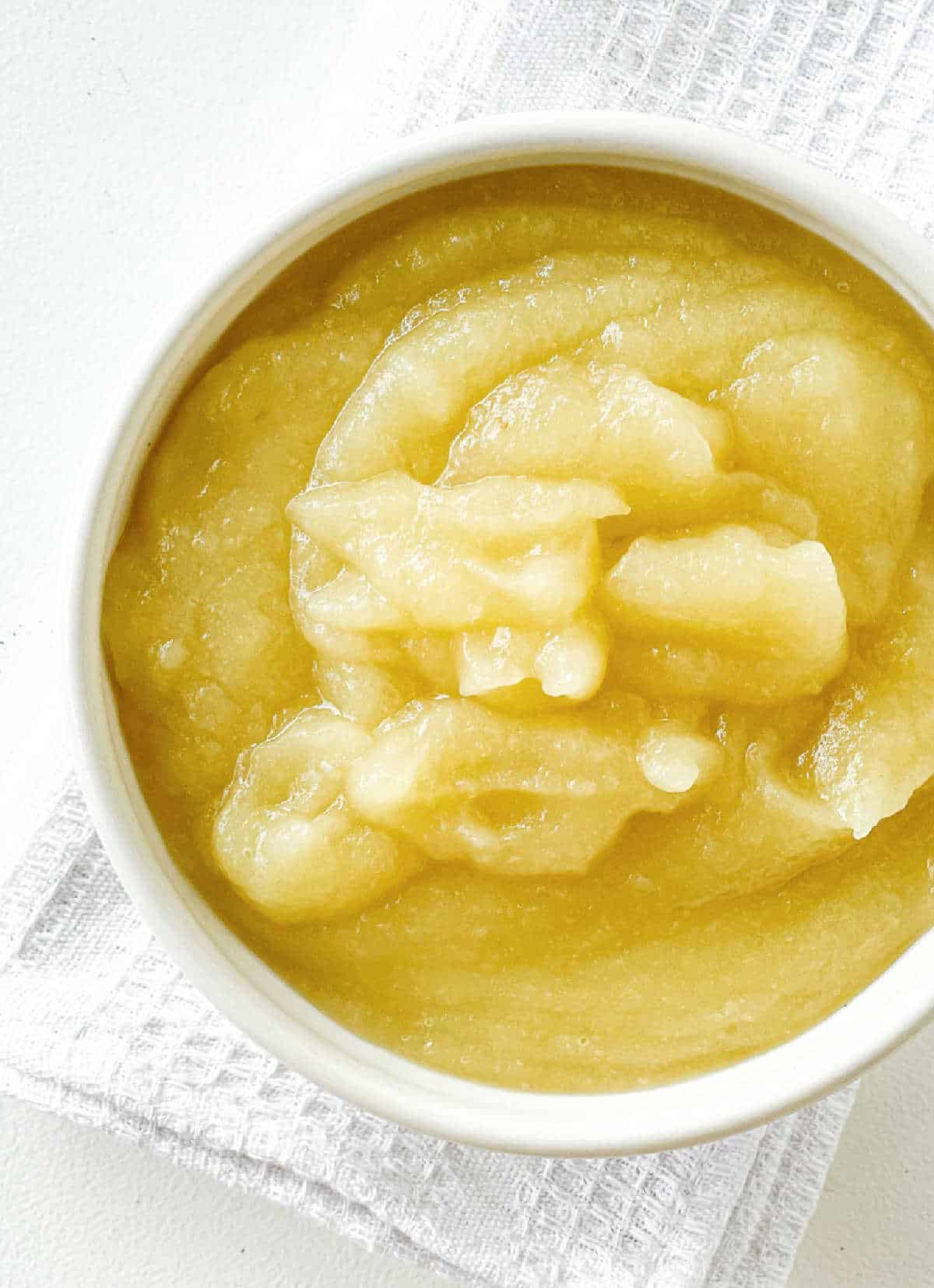
FAQ
It adds moisture, some sweetness, and can substitute certain ingredients like oil or butter, making the baked goods healthier. Muffins, cakes, and quick breads made with applesauce usually have a tender, soft and sweeter crumb.
About ¼ cup of applesauce can be used in place of an egg. It will vary depending on the type of recipe and the rest of the ingredients but that's a good place to start.
Yes, it does. For oil, the ratio is 1:1 in volume. That means 1 cup of applesauce per 1 cup of oil called for in the recipe. For butter, you should start at ½ cup of applesauce per 1 cup of butter. Always remember that all recipes are different and you might need to test a few times before getting to the exact final product you want.
Unsweetened applesauce can last for about 10 days in the refrigerator in an airtight jar. If you can do it with the correct process (sterilized jars and all), it will last a few months, maybe more. Sweetened applesauce, depending on the amount of added sugar, can last longer.
It can be if you compare apple puree with plain unsweetened applesauce. If talking about sweetened and/or flavored applesauce, they are different.
In my experience, I can make between 1 ½ cups to 2 cups per pound of apples. This is a good amount for almost any baking recipe containing applesauce.
Related recipes you might like:
One last thing
If you made this recipe and loved it, you can comment below and leave a five-star ⭐️ review. Also, if you had issues, let me know so we can troubleshoot together. I appreciate honest feedback and suggestions.
You can also subscribe to our FREE email series 'Baking the Best' and our regular newsletter. Or follow and save my recipes on Pinterest.
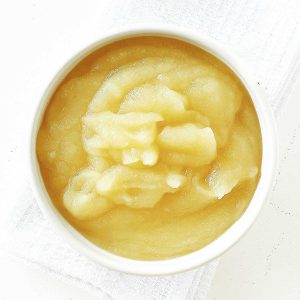
Best Homemade Applesauce (easy recipe)
Ingredients
For unsweetened applesauce:
- 2 pounds apples, before peeling (I use a mix of at least two, one of them Granny Smith (the green ones), and the other a red one, like red delicious, Gala or Fuji)
- ¼ to ½ cup water
For sweetened applesauce:
- ¼ cup white sugar, see Notes below for alternatives
Flavorings (optional):
- 2 strips lemon peel
- ½ teaspoon ground cinnamon
- ¼ teaspoon vanilla extract or paste
Instructions
- Peel, core, and cut apples into chunks.
- Put them in a medium saucepan or pot together with ¼ cup of water, and on the stove at low heat.
- Add the lemon peel and sugar if using. Mix.
- Cover and let come to a simmer. If you don't have a lid for the saucepan you're using, mix frequently over medium heat until it comes to a simmer.
- Uncover and let cook until the apples are very tender. Make sure you don't run out of water so the apples don't stick or scorch to the bottom of the pan. Add a few tablespoons more water if needed. The mixture will foam a lot and that is fine.
- Pierce the apples with a fork and remove them from the stove when they are very soft.
- Process them with an immersion blender in the same saucepan or use a potato masher or fork for chunkier applesauce. See Notes below for other methods.
- If, after you process it, it's too thin, you can return it to the stove (low heat) and cook it further, stirring constantly, until you get to the desired consistency.
- Let the hot applesauce cool down for a while before transferring it to an airtight jar and refrigerating for a week or so. For canning it, see the Top Tips section in the post.
- Freezing: after it's completely cooled down, you can use freezer bags or an appropriate airtight container and freeze the applesauce. It'll last several months.
Notes
Blender or food processor: if you use a blender, you might need to let it cool a little because not all blender jars are prepared to hold very hot mixtures. If you use a processor, make sure the amount of apples you make is enough for the steel blades to completely process them. If the amount is not large enough, sometimes the blades can't process it completely.
Food mill: this is another option for making the apple puree, especially if you don't peel the apples. Pass them through a stainless steel food mill to separate the pulp from the peel. Since I peel my apples, I don't use it, but it's an alternative if you already have it (it's also used for mashed potatoes). Uses: you can use it as a side dish (for pork chops for example), in baked goods like this Blueberry Pecan Loaf cake, or eat it with a spoon (baby food). I love to bake with applesauce and substitute it in some recipes to make them healthier. Below, in the frequently asked questions section, you can find how to do this. Canning: for longer storage, can this homemade applesauce recipe, like you would a jam. I'm not a canning expert, but here is an article on how to can applesauce.

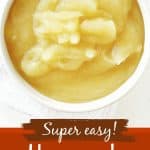
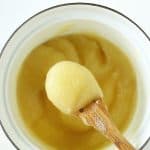
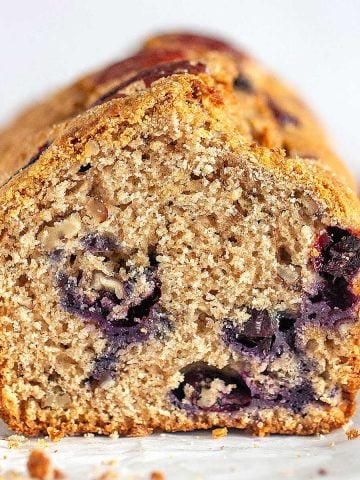
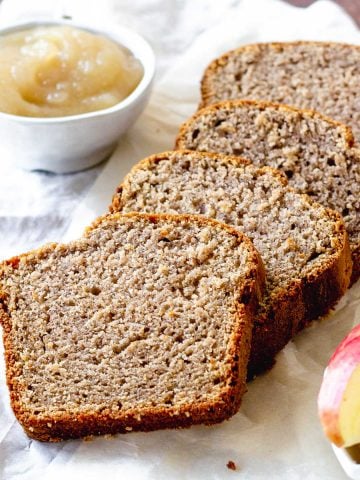
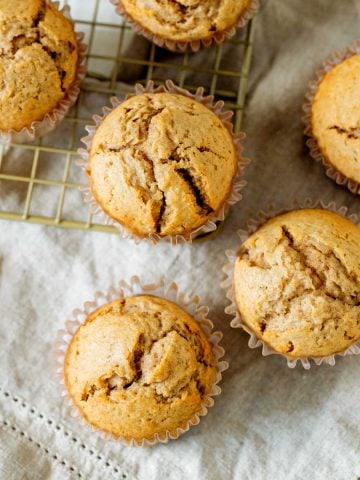
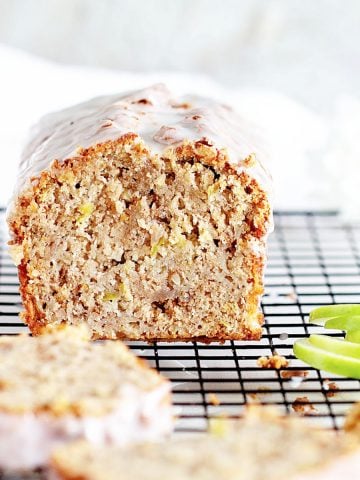
angiesrecipes says
Unsweetened, cinnamony applesauce for me please :-))